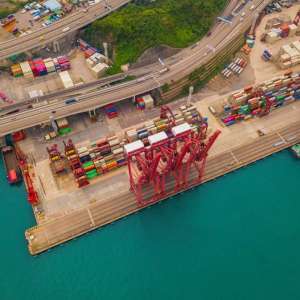A Comprehensive Guide to Shipping from Yangshan Ocean Port to Vietnam
Latest update on 25 July, 2024 by Angelina Pang– Marketing Analyst at FreightAmigo
Freight transportation plays a vital role in global trade, enabling the movement of goods across international borders. One of the busiest and most significant routes in the shipping industry is from Yangshan Ocean Port in China to various destinations in Vietnam. In this article, FreightAmigo will detail a comprehensive guide to shipping from Yangshan Port to Vietnam, covering an overview of Yangshan Port, transportation logistics, and the customs and regulations involved.
Want to Instantly Compare International Express, Air, Sea, Rail Freight And Truck Logistics Management Solutions To Control Transportation Costs?
Overview of Yangshan Ocean Port
Yangshan Ocean Por located on the Yangshan Islands. It is connected to the mainland by the Donghai Bridge, which spans over 30 kilometers. The port has several distinct features that make it a vital cog in the machinery of global trade.
State-of-the-Art Facilities
Yangshan Port is equipped with the latest technology and infrastructure to handle a massive volume of cargo efficiently. It boasts numerous deep-water berths that can accommodate the world’s largest container ships. The port’s automated systems, including robotic cranes and advanced tracking technologies, ensure smooth and efficient operations, reducing turnaround times and minimizing delays.
Strategic Location
The port’s proximity to major manufacturing hubs in China makes it an ideal starting point for freight destined for Vietnam. The strategic location allows for easy access to the vast network of transportation routes, including road, rail, and air, facilitating the seamless movement of goods from factories to the port and onward to Vietnam.
Logistics of Shipping from Yangshan to Vietnam
Shipping freight from Yangshan Ocean Port to Vietnam involves several key steps, each critical to ensuring the timely and efficient delivery of goods. Understanding these steps can help businesses streamline their logistics and avoid common pitfalls.
Booking and Documentation
The first step in the shipping process is booking cargo space with a reliable shipping line. This involves selecting the appropriate vessel and ensuring that all necessary documentation, such as bills of lading, invoices, and packing lists, is in order. Proper documentation is crucial to avoid delays and ensure compliance with customs regulations in both China and Vietnam.
Loading and Transportation
Once the cargo is booked and documentation is complete, the goods are transported to Yangshan Port and loaded onto the vessel. This stage involves several sub-steps, including containerization, inspection, and securing the cargo. The port’s advanced facilities and experienced workforce ensure that these processes are carried out efficiently and safely.
Transit and Arrival
The transit time from Yangshan Port to Vietnamese ports such as Ho Chi Minh City, Hai Phong, or Da Nang, typically ranges from a few days to a couple of weeks, depending on the shipping line and route. Upon arrival, the cargo undergoes customs clearance before being transported to its destination. Efficient handling at both ends of the journey is crucial to maintaining the integrity of the supply chain.
Customs and Regulations
Navigating the complex web of customs and regulations is a critical aspect of international freight shipping. Both China and Vietnam have specific requirements that must be met to ensure smooth clearance and avoid penalties or delays.
Chinese Export Regulations
China’s export regulations require that all goods leaving the country be thoroughly documented and inspected. This includes obtaining an export license, ensuring that the goods comply with Chinese export standards, and paying any applicable duties and taxes. Failure to comply with these regulations can result in significant delays and additional costs.
Vietnamese Import Regulations
Similarly, Vietnam has stringent import regulations that must be adhered to. Importers must provide detailed documentation, including commercial invoices, packing lists, and certificates of origin. Additionally, certain goods may be subject to inspection and quarantine requirements. Ensuring compliance with these regulations is essential to avoid delays and ensure that the goods can enter the Vietnamese market without issues.
Common Challenges and Solutions
Common challenges in the customs clearance process include delays due to incomplete or incorrect documentation, discrepancies in declared values, and non-compliance with import/export regulations. To mitigate these challenges, businesses should work with experienced freight forwarders and customs brokers who can navigate the regulatory landscape and ensure that all requirements are met.
Conclusion
Shipping freight from Yangshan Ocean Port to Vietnam is a complex but manageable process that requires careful planning and attention to detail. By understanding the capabilities of Yangshan Port, the logistics involved in the shipping process, and the customs regulations of both China and Vietnam, businesses can optimize their supply chains and ensure the timely and efficient delivery of goods. Working with FreightAmigo and staying informed of regulatory changes are key strategies for success on this important trade route. With the right approach, businesses can leverage the strengths of Yangshan Ocean Port and the growing Vietnamese market to achieve their international trade goals.
If you are looking for logistics experts, please visit FreightAmigo Page
Read More:
Guide to Freight From Beihai to Malaysia | FreightAmigo
An Ultimate Guide To Freight From Ningbo To Malaysia | FreightAmigo
Shipping from the United States to Hai Phong Port | FreightAmigo
If you have any inquiries on logistics / supply chain, feel free to contact FreightAmigo now:
Chat with us online | Hotline: +852 28121686 | WhatsApp: +852 27467829










































